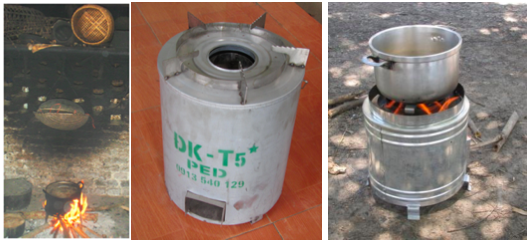Rice. The staple food of millions in the world. A crop of which India is the second largest producer. Rice also fetches India useful foreign exchange as it has demand in foreign markets. It sustains the livelihoods of numerous farmers and their families in several Indian states. Currently, well over 110 million tonnes of rice paddy are cultivated in India annually, over 20% of global production of this cereal. The states of West Bengal, Uttar Pradesh and Punjab account for nearly 40% of the cultivation. Now, if there is edible rice crop from the fields, there will be some organic inedible wastes as well – rice husk, in other words. As a percentage of the total production of rice crop (including the husk that is), husk accounts for around 20%. So, if one has 110 million tonnes of harvested crop, 22 million tonnes of rice husk will have to be dealt with (refer Figure 1)!
Dealing with the husk
As gathered from articles, rice husk is used for a plethora of applications in India. Cattle feeding, partition-board manufacturing, as fuel in brick kilns and furnaces, in rice mills themselves for the parboiling process (again as a source of heat energy), as a raw material for the production of chemicals like xylitol, furfural, ethanol, acetic acid and lignosulphonic acids, as a cleaning or polishing agent in the metalworking sector, and also in the manufacture of building materials. Husk is often also landfilled or just burnt in open piles (the latter being the most common mode of handling rice husk in Vietnam, the country in which the project referred to in the introduction, was carried out). Landfilling organic waste is simply not advisable. Just burning it and releasing carbon dioxide (and perhaps other gases which are noxious to living creatures), again, is simply an irresponsible attitude towards handling wastes which can and must be looked upon as resources – increasingly so in the 21st Century, when depletion of several resources is staring us all in the face. Looking upon cattle as scavengers and feeding them the rice husk may well be a ‘sin’, as not only does husk have low nutrition value, but being fibrous, it may also be harmful to the cattle. You may say, well, not as bad as the waste plastics which cattle eat and choke to death often…maybe, but yet, it simply is not right on man’s part to subject cattle to risks.
Using husk as a source of energy whereby most of the solid mass is converted to gaseous form, and about 20% of the mass is converted to ash which can find use as a concrete additive, a turn-dish powder for steel-casting because of its insulating properties, in the manufacture of refractory bricks, in industrial wastewater treatment as an adsorbent of oil, acids, mercury etc., in vulcanising rubber as a substitute for silica, and also in gas cleaning equipment to adsorb sulphur dioxide in coal power plants for example. Very well, as husk then is a source of bio-energy – clean and green. At 13.33 GJ/tonne, if combusted in a boiler, and then sent through a turbine to generate electricity at an efficiency of say 30%, the 22 million tonnes of rice husk, can theoretically provide an electricity output of 25 TWh per year. This would be about 2% of the total electricity generated in India, on date. If this would result in a reduction of coal power production equal to 25 TWh per year, then well, one can claim to have cut back greenhouse gas emissions, a wee bit. But, of that, one cannot really be sure!
Back to soil option
That brings us to the ‘back-to-the-soil’ option via the production of bio-char, which has been demonstrated in the said project recently. Biochar is a carbon-rich material which is commonly produced by low-temperature (300-600 °C) pyrolysis of uncontaminated biomass sources such as wood, crop residues, livestock manure or other organic wastes in an oxygen-limited environment. It has a high percentage of stable carbon, which resists decay, and remains in soil for long periods of time. Research shows that biochar can also improve soil functions, reduce the need for fertiliser and water, and increase crop productivity. However, the agronomic benefits of biochar application vary with the type of soil and biomass feedstock, climate, crop species, farmland management and pyrolysis conditions (temperature, residence time and heating rate).
Biochar can be produced at different scales – from small household cook-stoves to large modern pyrolysis facilities, which can also recover energy in addition to solid biochar. Using pyrolytic cook-stoves will enable small-scale (i.e., household) pyrolysis of biomass to produce biochar, in addition to heat energy for cooking. These improved cook-stoves will also contribute to the reduction of indoor air pollution by displacing the traditional three-stone (referred to as ‘3S’) cook-stoves (see Figure 2). Biochar cook-stoves will also decrease the time spent by families, in gathering fuel, while improving fuel efficiency by widening the variety of feedstock which could be used. Use of liquefied petroleum gas can be decreased (thereby contributing to a truncation of the greenhouse-gas-footprint) and deforestation can also be controlled to a significant extent. From a social sustainability point of view, results from the research conducted in Vietnam show that a reduction of cooking time by 25% enables mothers and womenfolk of households to spend more time with family members or with the rural community in general, and on educational or other income-generating activities.
The mechanisms through which biochar amendment affects methane (CH4) emissions in rice-cropping systems have been investigated in some studies. Biochar amendment is likely to make soil conditions unfavourable for methanogenic bacteria (methane-producing microbes, which are active in oxygen-starved soils) due to improved aeration. Enhancing soil aeration may also increase the degree of oxidation of methane which may still be produced in some quantities. The carbon dioxide which is emitted after methane is oxidised is considered as biogenic, and thereby not contributing to global warming, unlike methane gas.
Recent studies also show that biochar can enhance the composting process by improving aeration, retaining nutrients in the soil (nitrogen, phosphorus, potassium, etc.) and improving the quality of the end-product. A significant reduction in N losses has been achieved by mixing biochar and poultry litter compost in a 1:4 ratio; indicating that biochar can be a suitable amendment for the composting of N-rich waste materials.
On the other hand, the high rates of application of biochar – 10 tons or more per hectare – can increase expenditure. The development of enriched biochar, having higher mineral content, and co-composting of biochar with organic residues can overcome this economic constraint. Research studies in Vietnam have shown that biochar can be beneficial at lower rates if treated with minerals or mixed with composted manure and applied to soil as biochar-compost amendment.
The adoption of biochar technologies entails the addressing of the social and economic context, in addition to the environmental and health aspects. At a farm level, the economic benefits are the most important attributes impelling producers towards the adoption of this new technology. In a related research, the total cost for biochar production in the research area (North Vietnam) was estimated at US$ 118 per ton (equivalent to about US$ 29.5 per ton of rice residue feedstock processed). Using crop residues rather than forestry residues for biochar production is a more likely approach to reduce biochar costs as much as practically possible for smallholder farmers to gain an overall benefit from the investment in producing and using biochar. The findings of the economic analysis indicate that biochar addition can improve the net present value of rice production, vis-à-vis producing rice with the current residue management practice adopted in Vietnam – open-burning in the fields.
New and promising
Based on the research studies that recently have been done in Vietnam, in comparison with open burning of residues, producing biochar from rice residues (Figure 3) ensures controlled and cleaner combustion, generation of renewable energy (heat energy which can be recovered from the off-gases and bio-oil), reduction in net greenhouse gas emissions, decrease in synthetic fertiliser consumption, and enhanced crop productivity. The last two benefits indicate agronomic benefits for the farmers. It is worth introducing this technology in India, if it is not already being practised. (The second author would be keen on interacting with scientists and entrepreneurs in India, who may find this of interest.)


 [/column]
[/column] [/column]
[/column]